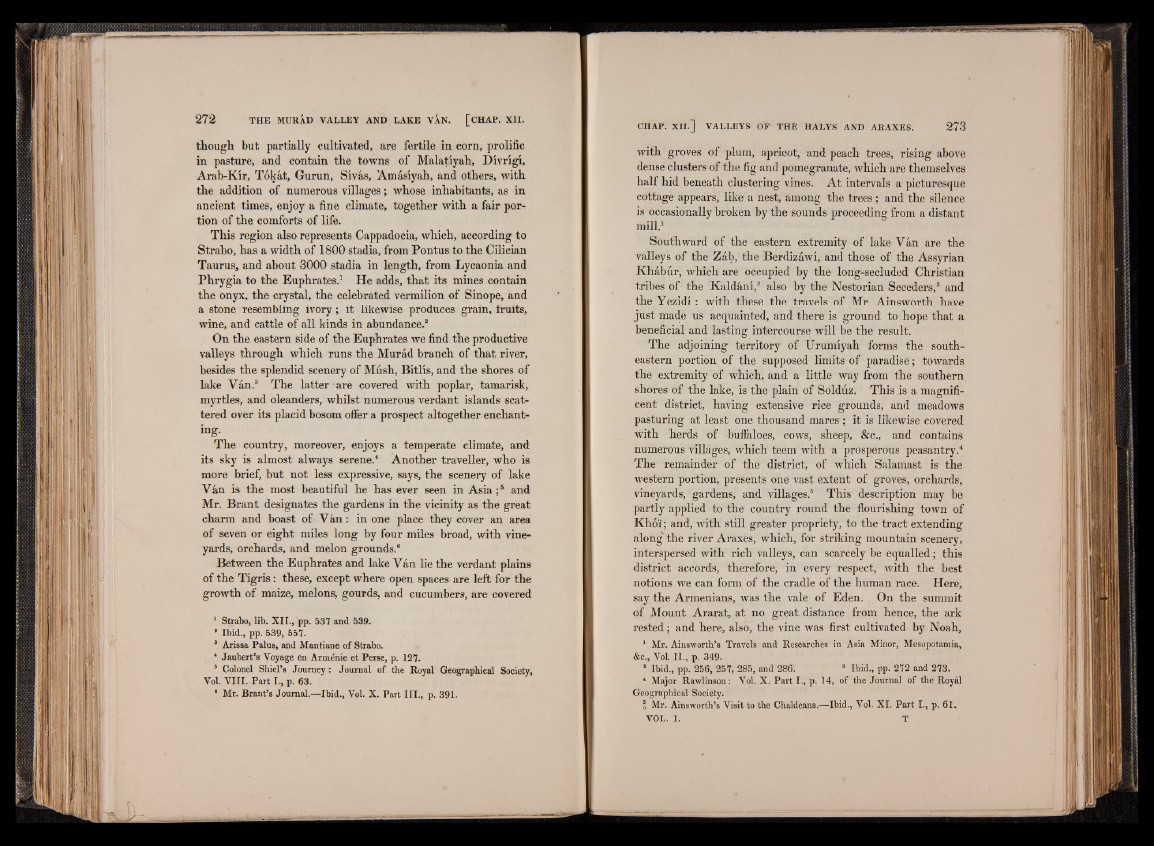
though but partially cultivated, are fertile in corn, prolific
in pasture, and contain the towns of Malatiyah, Divrigi,
Arab-Kir, Tokât, Gurun, Sivas, Amasiyah, and others, with
the addition of numerous villages ; whose inhabitants, as in
ancient times, enjoy a fine climate, together with a fair portion
of the comforts of life.
This region also represents Cappadocia, which, according to
Strabo, has a width of 1800 stadia, from Pontus to the Cilician
Taurus, and about 3000 stadia in length, from Lycaonia and
Phrygia to the Euphrates.1 He adds, that its mines contain
the onyx, the crystal, the celebrated vermilion of Sinope, and
a stone resembling ivory ; it likewise produces grain, fruits,
wine, and cattle of all kinds in abundance.2
On the eastern side of the Euphrates we find the productive
valleys through which runs the Murad branch of that river,
besides the splendid scenery of Mush, Bitlis, and the shores of
lake V an.3 The latter are covered with poplar, tamarisk,
myrtles, and oleanders, whilst numerous verdant islands scattered
over its placid bosom offer a prospect altogether enchanting
.T
he country, moreover, enjoys a temperate climate, and
its sky is almost always serene.4 Another traveller, who is
more brief, but not less expressive, says, the scenery of lake
Van is the most beautiful he has ever seen in Asia ;5 and
Mr. Brant designates the gardens in the vicinity as the great
charm and boast of Van : in one place they cover an area
of seven or eight miles long by four miles broad, with vineyards,
orchards, and melon grounds.6
Between the Euphrates and lake Van lie the verdant plains
of the Tigris : these, except where open spaces are left for the
growth of maize, melons, gourds, and cucumbers, are covered
1 Strabo, lib. XII., pp. 531 and 539.
* Ibid., pp. 539, 557.
8 Arissa Palus, and Mantiane of Strabo.
4 Jaubert’s Voyage en Arménie et Perse, p. 127.
4 Colonel Shiel’s Journey : Journal of the Royal Geographical Society,
Vol. V III. Part I., p. 63.
' Mr. Brant’s Journal.—Ibid., Vol. X. Part III., p. 391.
with groves of plum, apricot, and peach trees, rising above
dense clusters of the fig and pomegranate, which are themselves
half hid beneath clustering vines. At intervals a picturesque
cottage appears, like a nest, among the trees; and the silence
is occasionally broken by the sounds proceeding from a distant
mill.1
Southward of the eastern extremity of lake Van are the
valleys of the Zab, the Berdizawi, and those of the Assyrian
Khabur, which are occupied by the long-secluded Christian
tribes of the Kaldani,2 also by the Nestorian Seceders,3 and
the Yezidi: with these the travels of Mr. Ainsworth have
just made us acquainted, and there is ground to hope that a
beneficial and lasting intercourse will be the result.
The adjoining territory of Urumiyah forms the southeastern
portion of the supposed limits of paradise; towards
the extremity of which, and a little way from the southern
shores of the lake, is the plain of Solduz. This is a magnificent
district, having extensive rice grounds, and meadows
pasturing at least one thousand mares ; it is likewise covered
with herds of buffaloes, cows, sheep, &c., and contains
numerous villages, which teem with a prosperous peasantry.4
The remainder of the district, of which Salamast is the
western portion, presents one vast extent of groves, orchards,
vineyards, gardens, and villages.5 This description may be
partly applied to the country round the flourishing town of
Khoi; and, with still greater propriety, to the tract extending
along the river Araxes, which, for striking mountain scenery,
interspersed with rich valleys, can scarcely be equalled; this
district accords, therefore, in every respect, with the best
notions we can form of the cradle of the human race. Here,
say the Armenians, was the vale of Eden. On the summit
of Mount Ararat, at no great, distance from hence, the ark
rested; and here, also, the vine was first cultivated by Noah,
1 Mr. Ainsworth’s Travels and Researches in Asia Minor, Mesopotamia,
&c., Vol. II., p. 349.
2 Ibid., pp. 256, 257, 285, and 286. 8 Ibid., pp. 272 and 273.
4 Major Rawlinson: Vol. X. Part I., p. 14, of the Journal of the Royal
Geographical Society.
5 Mr. Ainsworth’s Visit to the Chaldeans.—Ibid., Vol. XI. Part I., p. 61.
VOL. I. T .